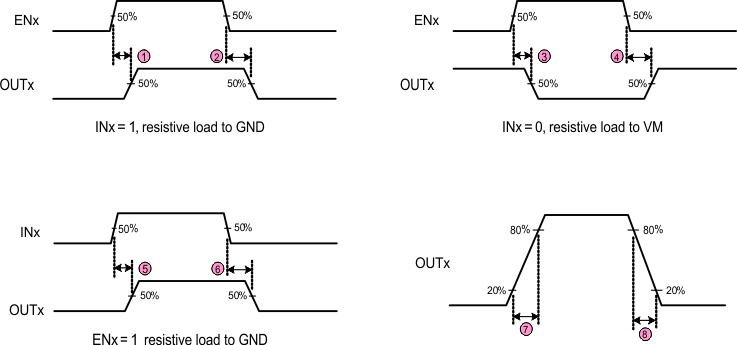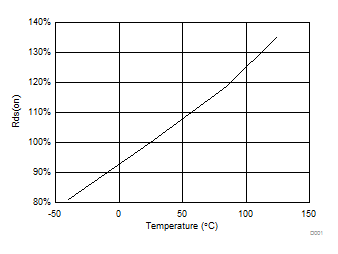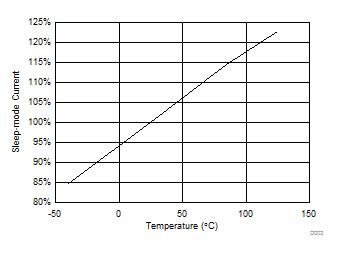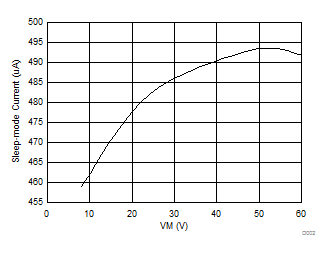SLVSBA2D July 2012 – May 2016 DRV8844
PRODUCTION DATA.
- 1 Features
- 2 Applications
- 3 Description
- 4 Revision History
- 5 Pin Configuration and Functions
- 6 Specifications
- 7 Detailed Description
- 8 Application and Implementation
- 9 Power Supply Recommendations
- 10Layout
- 11Device and Documentation Support
- 12Mechanical, Packaging, and Orderable Information
Package Options
Mechanical Data (Package|Pins)
- PWP|28
Thermal pad, mechanical data (Package|Pins)
- PWP|28
Orderable Information
6 Specifications
6.1 Absolute Maximum Ratings
over operating free-air temperature range (unless otherwise noted)(1)| MIN | MAX | UNIT | ||
|---|---|---|---|---|
| VM | Power supply voltage | –0.3 | 65 | V |
| Logic ground voltage (LGND) | –0.5 | VM - 8 | V | |
| Digital pin voltage | LGND – 0.5 | LGND + 7 | V | |
| SRC12, SRC34 (pins 6 and 9 with optional sense resistor) to VNEG pins (pins 14 and 28) | –0.6 | 0.6 | V | |
| Peak motor drive output current, t < 1 μs | Internally limited | A | ||
| Continuous motor drive output current(2) | 2.5 | A | ||
| TJ | Operating virtual junction temperature | –40 | 150 | °C |
| Tstg | Storage temperature | –60 | 150 | °C |
(1) Stresses beyond those listed under Absolute Maximum Ratings may cause permanent damage to the device. These are stress ratings only, which do not imply functional operation of the device at these or any other conditions beyond those indicated under Recommended Operating Conditions. Exposure to absolute-maximum-rated conditions for extended periods may affect device reliability.
(2) Power dissipation and thermal limits must be observed.
6.2 ESD Ratings
| VALUE | UNIT | ||||
|---|---|---|---|---|---|
| V(ESD) | Electrostatic discharge | Human body model (HBM), per ANSI/ESDA/JEDEC JS-001(1) | ±3000 | V | |
| Charged device model (CDM), per JEDEC specification JESD22-C101(2) | ±1500 | ||||
(1) JEDEC document JEP155 states that 500-V HBM allows safe manufacturing with a standard ESD control process.
(2) JEDEC document JEP157 states that 250-V CDM allows safe manufacturing with a standard ESD control process.
6.3 Recommended Operating Conditions
over operating free-air temperature range, all voltages relative to VNEG terminal (unless otherwise noted)| MIN | NOM | MAX | UNIT | ||
|---|---|---|---|---|---|
| VM | Motor power supply voltage(1) | 8 | 60 | V | |
| IV3P3 | V3P3OUT load current | 0 | 10 | mA | |
| TA | Ambient temperature | –40 | 125 | °C | |
(1) All VM pins must be connected to the same supply voltage.
6.4 Thermal Information
| THERMAL METRIC(1) | DRV8844 | UNIT | |
|---|---|---|---|
| PWP (HTSSOP) | |||
| 16 PINS | |||
| RθJA | Junction-to-ambient thermal resistance | 31.6 | °C/W |
| RθJC(top) | Junction-to-case (top) thermal resistance | 15.9 | °C/W |
| RθJB | Junction-to-board thermal resistance | 5.6 | °C/W |
| ψJT | Junction-to-top characterization parameter | 0.2 | °C/W |
| ψJB | Junction-to-board characterization parameter | 5.5 | °C/W |
| RθJC(bot) | Junction-to-case (bottom) thermal resistance | 1.4 | °C/W |
(1) For more information about traditional and new thermal metrics, see the Semiconductor and IC Package Thermal Metrics application report, SPRA953.
6.5 Electrical Characteristics
TA = 25°C, over operating free-air temperature range, all voltages relative to VNEG terminal (unless otherwise noted)| PARAMETER | TEST CONDITIONS | MIN | TYP | MAX | UNIT | |
|---|---|---|---|---|---|---|
| POWER SUPPLIES | ||||||
| IVM | VM operating supply current | VM = 24 V, fPWM < 50 kHz | 1 | 5 | mA | |
| IVMQ | VM sleep mode supply current | VM = 24 V | 500 | 800 | μA | |
| VUVLO | VM undervoltage lockout voltage | VM rising | 6.3 | 8 | V | |
| V3P3OUT REGULATOR | ||||||
| V3P3 | V3P3OUT voltage | IOUT = 0 to 1 mA | 3.18 | 3.3 | 3.52 | V |
| LOGIC-LEVEL INPUTS | ||||||
| VIL | Input low voltage | LGND + 0.6 | LGND + 0.7 | V | ||
| VIH | Input high voltage | LGND + 2.2 | LGND + 5.25 | V | ||
| VHYS | Input hysteresis | 50 | 600 | mV | ||
| IIL | Input low current | VIN = LGND | –5 | 5 | μA | |
| IIH | Input high current | VIN = LGND + 3.3 V | 100 | μA | ||
| RPD | Internal pulldown resistance | 100 | kΩ | |||
| nFAULT OUTPUT (OPEN-DRAIN OUTPUT) | ||||||
| VOL | Output low voltage | IO = 5 mA | LGND + 0.5 | V | ||
| IOH | Output high leakage current | VO = LGND + 3.3 V | 1 | μA | ||
| H-BRIDGE FETS | ||||||
| RDS(ON) | HS FET on resistance | VM = 24 V, IO = 1 A, TJ = 25°C | 0.24 | Ω | ||
| VM = 24 V, IO = 1 A, TJ = 85°C | 0.29 | 0.39 | ||||
| LS FET on resistance | VM = 24 V, IO = 1 A, TJ = 25°C | 0.24 | ||||
| VM = 24 V, IO = 1 A, TJ = 85°C | 0.29 | 0.39 | ||||
| IOFF | Off-state leakage current | –2 | 2 | μA | ||
| PROTECTION CIRCUITS | ||||||
| IOCP | Overcurrent protection trip level | 3 | 5 | A | ||
| tDEAD | Output dead time | 90 | ns | |||
| tOCP | Overcurrent protection deglitch time | 5 | µs | |||
| TTSD | Thermal shutdown temperature | Die temperature | 150 | 160 | 180 | °C |
6.6 Switching Characteristics
over operating free-air temperature range (unless otherwise noted)(1) (see Figure 1)| NUMBER | PARAMETER | TEST CONDITIONS | MIN | MAX | UNIT |
|---|---|---|---|---|---|
| 1 | t1 | Delay time, ENx high to OUTx high, INx = 1 | 130 | 330 | ns |
| 2 | t2 | Delay time, ENx low to OUTx low, INx = 1 | 275 | 475 | ns |
| 3 | t3 | Delay time, ENx high to OUTx low, INx = 0 | 100 | 300 | ns |
| 4 | t4 | Delay time, ENx low to OUTx high, INx = 0 | 200 | 400 | ns |
| 5 | t5 | Delay time, INx high to OUTx high | 300 | 500 | ns |
| 6 | t6 | Delay time, INx low to OUTx low | 275 | 475 | ns |
| 7 | tR | Output rise time, resistive load to VNEG | 30 | 150 | ns |
| 8 | tF | Output fall time, resistive load to VNEG | 30 | 150 | ns |
(1) Not production tested – specified by design
 Figure 1. DRV8844 Switching Characteristics
Figure 1. DRV8844 Switching Characteristics
6.7 Typical Characteristics


